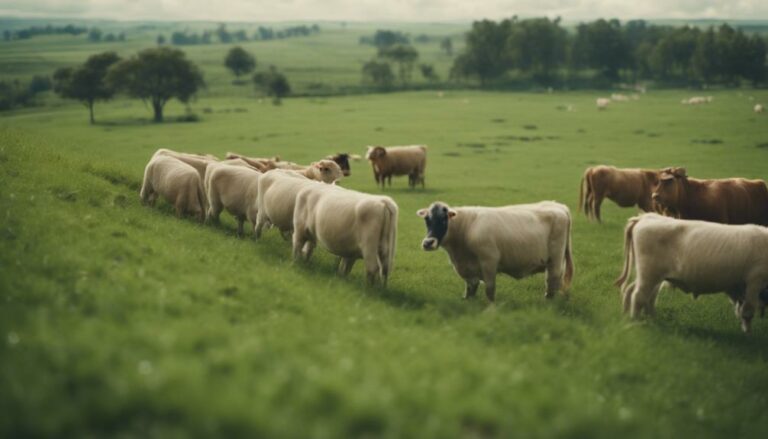As you contemplate ways to enhance your pasture management practices, have you ever considered the advantages of rotational grazing? This sustainable approach not only benefits the environment but also contributes to the well-being of your livestock. By implementing a rotational system, you can improve soil health, increase productivity, and support biodiversity on your land. But the benefits don't stop there; there's more to uncover about how this method can revolutionize your farming practices.
Key Takeaways
- Increase gain per acre and promote even cattle distribution for better pasture utilization.
- Enhance soil health through rotational grazing, allowing for vegetation recovery and improved nutrient cycling.
- Maximize nutrient intake for horses by providing access to diverse, nutrient-rich forage.
- Improve pasture health and productivity by implementing strategic grazing practices.
- Sustainable land management practices like rotational systems boost economic resilience and community impact.
Benefits of Rotational Grazing Systems
Rotational grazing systems have been shown to significantly increase gain per acre and promote a more even distribution of cattle across the land. This method not only benefits livestock but also plays a significant role in enhancing soil health. By rotating cattle through different grazing areas, the impact on any one section of land is minimized, allowing for vegetation recovery and preventing overgrazing. This results in improved soil structure, increased organic matter content, and enhanced nutrient cycling.
Studies have demonstrated that rotational grazing positively influences soil health by reducing compaction, promoting better water infiltration, and enhancing microbial activity. Healthier soils lead to increased forage growth, which in turn supports higher stocking rates and improved livestock performance. Additionally, the reduced need for chemical fertilizers and pesticides in well-managed rotational grazing systems further contributes to environmental sustainability.
Maximizing Nutrient Intake for Horses
Maximizing nutrient intake for horses can be achieved through strategic rotational grazing practices that guarantee continuous access to fresh, diverse forage, promoting balanced nutrition and peak health.
- Rotational grazing allows horses to access fresh, high-quality forage in each paddock rotation.
- Moving horses between paddocks regularly promotes continuous access to diverse plant species, fostering balanced nutrition.
- Resting paddocks in rotational systems help maintain forage quality, ensuring horses receive adequate nutrients for peak health.
- Rotating pastures provides horses with the opportunity to graze on nutrient-rich grasses and legumes, supporting their dietary needs.
- Effective rotational grazing management enhances nutrient intake for horses, leading to improved overall health and performance.
Improving Pasture Health and Productivity
Improving pasture health and productivity involves implementing strategic grazing practices that enhance plant diversity and soil fertility. Rotational grazing, through its management practices, plays a significant role in achieving these goals.
Research indicates that rotational grazing increases pasture sustainability by promoting diverse plant growth and soil health. Grazing patterns in such systems not only improve pasture productivity but also enhance nutrient cycling within the ecosystem.
Over time, proper rotational grazing leads to enhanced pasture biodiversity and increased soil fertility, benefiting the overall health of the pasture. Healthy pastures resulting from rotational grazing support livestock well-being, reducing the need for external interventions and veterinary care.
Additionally, this method contributes to erosion control, creating greener pastures that are more environmentally sustainable. By following strategic rotational grazing management practices, farmers can optimize their pasture health and productivity, ultimately increasing the yield per acre while maintaining ecological balance.
Sustainable Land Management Practices
Enhancing sustainable land management practices involves implementing strategies that promote soil health, biodiversity conservation, and economic resilience on agricultural landscapes. Rotational grazing systems play an important role in achieving these goals through various mechanisms:
- Rotational systems: Implementing rotational grazing enhances soil health by promoting fertility, reducing erosion, and improving water infiltration.
- Soil health: Rotational grazing boosts organic matter content in the soil, supporting a diverse microbiome and decreasing greenhouse gas emissions.
- Biodiversity conservation: Livestock rotation in grazing systems helps preserve biodiversity, mitigate water pollution, and create wildlife habitats.
- Economic resilience: The economic advantages of rotational grazing include lower operational costs, increased land productivity, and enhanced farm resilience.
- Community impact: Rotational grazing fosters community impact by promoting sustainable food production, supporting local economies, and educating about agriculture.
Enhancing Horse Well-Being Through Grazing
Moving from sustainable land management practices to the specific area of horse care, optimizing horse well-being through grazing involves strategic rotational management of paddocks to ensure ideal forage availability and pasture health. Rotational grazing for horses necessitates the movement of horses between paddocks regularly to prevent overgrazing and support pasture health. One key aspect is the incorporation of resting paddocks, which are essential for allowing forage regrowth, maintaining pasture health, and ensuring horses have access to quality grazing areas. Horses should not remain in a paddock for more than seven days to promote excellent grazing management and prevent overutilization of forage resources.
Utilizing temporary electric fencing can aid in subdividing paddocks effectively, lowering costs, and enhancing rotational grazing strategies for horses. By controlling when and where horses graze, rotational grazing management supports the well-being of horses by providing them with varied and fresh forage, promoting exercise, and reducing the risk of parasite transmission.
| Benefits of Rotational Grazing for Horses | ||
|---|---|---|
| Prevents overgrazing | Supports pasture health | Enhances forage availability |
Conclusion
To sum up, rotational grazing provides a lush oasis for both livestock and land. By strategically rotating cattle, farmers can tap into the full potential of their pastures, fostering a thriving ecosystem where nutrients flow like a river and biodiversity blooms like a garden.
This sustainable practice not only enhances soil health and livestock well-being but also sets the stage for a greener future where harmony between animals and the environment prevails.

